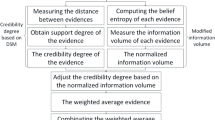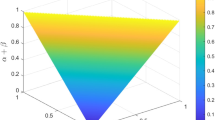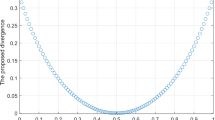Abstract
Dempster–Shafer (D–S) theory of evidence is widely used in many real application systems. It can not only deal with imprecise and uncertain information but also combine evidences of different sensors. Therefore it plays an important role in multi-sensor reports’ combination in fault diagnosis. However, when the evidences highly conflict with others, Dempster’s combination rule may lead to a counter-intuitive result and come to a wrong conclusion. It is inevitable to handle conflict in fault diagnosis. This paper proposes a new method to address the issue. Deng entropy function is adopted to measure the information volume of evidences. Evidence distance is introduced to represent the compatibility of evidences. An improved combination method considering both the uncertainty of evidences and the conflict degree of the system is proposed. The proposed method can deal with conflicting evidences efficiently. An application in fault diagnosis is illustrated to show the efficiency of the new method and the result is compared with that of other methods. Besides, and example in IRIS based on information fusion is given to validate the accuracy of the proposed method.
Similar content being viewed by others
References
Deli I (2017) Interval-valued neutrosophic soft sets and its decision making. Int J Mach Learn Cybern 8(2):665–676
Dempster AP (1966) Upper and lower probabilities induced by a multivalued mapping. Classic Works Dempster–Shafer Theory Belief Funct 38(2):57–72
Deng X, Han D, Dezert J, Deng Y, Shyr Y (2016) Evidence combination from an evolutionary game theory perspective. IEEE Trans Cybern 46(9):2070–2082
Deng X, Liu Q, Deng Y (2016) Matrix games with payoffs of belief structures. Appl Math Comput 273:868–879
Deng X, Liu Q, Deng Y, Mahadevan S (2016) An improved method to construct basic probability assignment based on the confusion matrix for classification problem. Inf Sci 340:250–261
Deng X, Xiao F, Deng Y (2017) An improved distance-based total uncertainty measure in belief function theory. Appl Intell 46(4):898–915
Deng Y (2016) Deng entropy. Chaos Solitons Fractals 91:549–553
Deng Y (2017) Fuzzy analytical hierarchy process based on canonical representation on fuzzy numbers. J Comput Anal Appl 22(2):201–228
Deng Y, Shi W, Zhu Z, Liu Q (2004) Combining belief functions based on distance of evidence. Decis Support Syst 38(3):489–493
Du Y, Lu X, Su X, Hu Y, Deng Y (2016) New failure mode and effects analysis: an evidential downscaling method. Qual Reliab Eng Int 32(2):737–746
Dubois D, Prade H (1988) Representation and combination of uncertainty with belief functions and possibility measures. Comput Intell 4(3):244–264
Fan X, Zuo MJ (2006) Fault diagnosis of machines based on D–S evidence theory. Part 1: D–S evidence theory and its improvement. Pattern Recognit Lett 27(5):366–376
Garcia ML (2005) Vulnerability assessment of physical protection systems. Butterworth-Heinemann
Goyal RK, Kaushal S (2016) A constrained non-linear optimization model for fuzzy pairwise comparison matrices using teaching learning based optimization. Appl Intell. doi:10.1007/s10489-016-0777-z
Hu Y, Du F, Zhang HL (2016) Investigation of unsteady aerodynamics effects in cycloidal rotor using RANS solver. Aeronaut J 120(1228):956–970
Jiang W, Wei B, Tang Y, Zhou D (2017) Ordered visibility graph average aggregation operator: an application in produced water management. Chaos Interdiscip J Nonlinear Sci 27(2). Article ID 023,117
Jiang W, Wei B, Zhan J, Xie C, Zhou D (2016) A visibility graph power averaging aggregation operator: a methodology based on network analysis. Comput Ind Eng 101:260–268
Jiang W, Xie C, Luo Y, Tang Y (2017) Ranking z-numbers with an improved ranking method for generalized fuzzy numbers. J Intell Fuzzy Syst 32(3):1931–1943
Jiang W, Xie C, Zhuang M, Tang Y (2017) Failure mode and effects analysis based on a novel fuzzy evidential method. Appl Soft Comput 57:672–683
Jiang W, Zhan J (2017) A modified combination rule in generalized evidence theory. Appl Intell 46(3):630–640
Jiang W, Zhuang M, Xie C, Wu J (2017) Sensing attribute weights: a novel basic belief assignment method. Sensors 17(4). Article ID 721
Jones RW, L.A.H.M. (2002) A framework for intelligent medical diagnosis using the theory of evidence. Knowl Based Syst 15(01):77–84(8)
Jousselme AL, Grenier D, Bossé É (2001) A new distance between two bodies of evidence. Inf Fusion 2(2):91–101
Li M, Hu Y, Zhang Q, Deng Y (2016) A novel distance function of D numbers and its application in product engineering. Eng Appl Artif Intell 47(SI):61–67
Li Y, Chen J, Ye F, Liu D (2016) The improvement of DS evidence theory and its application in IR/MMW target recognition. J Sensors (1903792). doi:10.1155/2016/1903792
Liang C, Zhao S, Zhang J (2017) Multi-criteria group decision making method based on generalized intuitionistic trapezoidal fuzzy prioritized aggregation operators. Int J Mach Learn Cybern 8(2):597–610
Liu J, Lian F, Mallick M (2016) Distributed compressed sensing based joint detection and tracking for multistatic radar system. Inf Sci 369:100–118
Ma J, Liu W, Miller P, Zhou H (2016) An evidential fusion approach for gender profiling. Inf Sci 333:10–20
Mardani A, Jusoh A, Zavadskas EK (2015) Fuzzy multiple criteria decision-making techniques and applications—two decades review from 1994 to 2014. Expert Syst Appl 42(8):4126–4148
Mo H, Lu X, Deng Y (2016) A generalized evidence distance. J Syst Eng Electron 27(2):470–476
Moosavian A, Khazaee M, Najafi G, Kettner M, Mamat R (2015) Spark plug fault recognition based on sensor fusion and classifier combination using dempster-shafer evidence theory. Appl Acoust 93:120–129
Murphy CK (2000) Combining belief functions when evidence conflicts. Decis Support Syst 29(1):1–9
Petrou ZI, Kosmidou V, Manakos I, Stathaki T, Adamo M, Tarantino C, Tomaselli V, Blonda P, Petrou M (2014) A rule-based classification methodology to handle uncertainty in habitat mapping employing evidential reasoning and fuzzy logic. Pattern Recognit Lett 48:24–33
Smets P (1990) The combination of evidence in the transferable belief model. Arn Analy Mahn Nllgn Ranaon 12(5):447–458
Sabahi F (2016) A novel generalized belief structure comprising unprecisiated uncertainty applied to aphasia diagnosis. J Biomed Inf 62:66–77
Sarabi-Jamab A, Araabi BN, Augustin T (2013) Information-based dissimilarity assessment in Dempster–Shafer theory. Knowl Based Syst 54(SI):114–127
Shafer G et al (1976) A mathematical theory of evidence, vol 1. Princeton university press, Princeton
Smets P (1993) Belief functions: the disjunctive rule of combination and the generalized bayesian theorem. Int J Approx Reason 9(1):1–35
Song M, Jiang W (2016) Engine fault diagnosis based on sensor data fusion using evidence theory. Adv Mech Eng 8(10):1–9
Song Y, Wang X, Lei L, Yue S (2016) Uncertainty measure for interval-valued belief structures. Measurement 80:241–250
Wang J, Hu Y, Xiao F, Deng X, Deng Y (2016) A novel method to use fuzzy soft sets in decision making based on ambiguity measure and Dempster–Shafer theory of evidence: an application in medical diagnosis. Artif Intell Med 69:1–11
Wang J, Xiao F, Deng X, Fei L, Deng Y (2016) Weighted evidence combination based on distance of evidence and entropy function. Int J Distrib Sensor Netw. doi:10.1177/155014773218784
Wang X, Chen A, Feng H (2011) Upper integral network with extreme learning mechanism. Neurocomputing 74(16):2520–2525
Wang X, Tsang EC, Zhao S, Chen D, Yeung DS (2007) Learning fuzzy rules from fuzzy samples based on rough set technique. Inf Sci 177(20):4493–4514
Wang X, Yeung DS, Tsang ECC (2001) A comparative study on heuristic algorithms for generating fuzzy decision trees. Syst Man Cybern Part B IEEE Trans Cybern 31(2):215–226
Wang XZ, Dong LC, Yan JH (2012) Maximum ambiguity-based sample selection in fuzzy decision tree induction. IEEE Trans Knowl Data Eng 24(8):1491–1505
Xizhao W, Minghu H (1992) Fuzzy linear regression analysis. Fuzzy Sets Syst 51(2):179–188
Xu X, Li S, Song X, Wen C, Xu D (2016) The optimal design of industrial alarm systems based on evidence theory. Control Eng Pract 46:142–156
Xu X, Liu P, Sun Y, Wen C (2014) Fault diagnosis based on the updating strategy of interval-valued belief structures. Chin J Electron 23(4)
Yager RR (1987) On the Dempster–Shafer framework and new combination rules. Inf Sci 41(2):93–137
Yu C, Yang J, Yang D, Ma X, Min H (2015) An improved conflicting evidence combination approach based on a new supporting probability distance. Expert Syst Appl 42(12):5139–5149
Zavadskas EK, Antucheviciene J, Turskis Z, Adeli H (2016) Hybrid multiple-criteria decision-making methods: a review of applications in engineering. Sci Iran 23(1):1–20
Zhang L, Wu X, Zhu H, AbouRizk SM (2017) Perceiving safety risk of buildings adjacent to tunneling excavation: an information fusion approach. Autom Constr 73:88–101
Zhang R, Ran X, Wang C, Deng Y (2016) Fuzzy evaluation of network vulnerability. Qual Reliab Eng Int 32(5):1715–1730
Zhang S, Feng T (2016) Optimal decision of multi-inconsistent information systems based on information fusion. Int J Mach Learn Cybern 7(4):563–572
Zhang X, Adamatzky A, Yang XS, Yang H, Mahadevan S, Deng Y (2016) A physarum-inspired approach to supply chain network design. Sci China Inf Sci 59(5):052,203
Zhang X, Deng Y, Chan FTS, Adamatzky A, Mahadevan S (2016) Supplier selection based on evidence theory and analytic network process. Proc Inst Mech Eng Part B J Eng Manuf 230(3):562–573
Zhang X, Deng Y, Chan FTS, Mahadevan S (2015) A fuzzy extended analytic network process-based approach for global supplier selection. Appl Intell 43(4):760–772
Zhao Y, Mi JS, Liu X, Sun XY (2017) Reconstructing images corrupted by noise based on d-s evidence theory. Int J Mach Learn Cybern 8(2):611–618
Zhou H, Wang JQ, Zhang HY (2017) Grey stochastic multi-criteria decision-making based on regret theory and topsis. Int J Mach Learn Cybern 8(2):651–664
Acknowledgements
The authors greatly appreciate the reviews’ suggestions and the editor’s encouragement. The work is partially supported by National Natural Science Foundation of China (Grant nos. 61573290,61503237).
Author information
Authors and Affiliations
Corresponding author
Rights and permissions
About this article
Cite this article
Yuan, K., Deng, Y. Conflict evidence management in fault diagnosis. Int. J. Mach. Learn. & Cyber. 10, 121–130 (2019). https://doi.org/10.1007/s13042-017-0704-6
Received:
Accepted:
Published:
Issue Date:
DOI: https://doi.org/10.1007/s13042-017-0704-6




